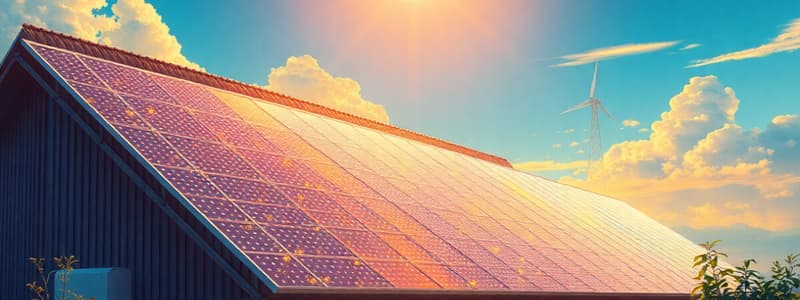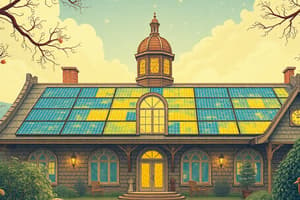Podcast
Questions and Answers
What type of solar collector is used in a system that requires no circulation pumps?
What type of solar collector is used in a system that requires no circulation pumps?
- Active solar systems
- Concentrated solar power systems
- High-efficiency collectors
- Thermosyphon systems (correct)
Which solar collector design is typically used in low-to-medium temperature applications?
Which solar collector design is typically used in low-to-medium temperature applications?
- Concentrator collectors
- Vacuum tube collectors
- Flat plate collectors (correct)
- Reflective collectors
What is the primary difference in the installation direction of solar collectors between the northern and southern hemispheres?
What is the primary difference in the installation direction of solar collectors between the northern and southern hemispheres?
- Both face east regardless of hemisphere
- Northern faces north; southern faces south
- Northern faces south; southern faces north (correct)
- Northern faces directly overhead; southern faces east
What is the typical coverage of hot water load for a family of four using a natural circulation system?
What is the typical coverage of hot water load for a family of four using a natural circulation system?
How is the tilt angle for solar collectors generally recommended to be set?
How is the tilt angle for solar collectors generally recommended to be set?
What is a characteristic of medium and high temperature concentrating solar collectors?
What is a characteristic of medium and high temperature concentrating solar collectors?
Which type of solar system generally requires less maintenance?
Which type of solar system generally requires less maintenance?
What factor influences the complexity and cost of solar thermal systems?
What factor influences the complexity and cost of solar thermal systems?
What is the maximum temperature for low temperature solar thermal installations?
What is the maximum temperature for low temperature solar thermal installations?
Which application typically requires a temperature of about 70 ºC in solar thermal energy systems?
Which application typically requires a temperature of about 70 ºC in solar thermal energy systems?
Which of the following is a characteristic of active solar thermal systems?
Which of the following is a characteristic of active solar thermal systems?
What is a disadvantage of passive solar thermal systems?
What is a disadvantage of passive solar thermal systems?
For which temperature range are medium temperature solar thermal installations designed?
For which temperature range are medium temperature solar thermal installations designed?
Which of the following processes can utilize high temperature solar thermal installations?
Which of the following processes can utilize high temperature solar thermal installations?
What is a key advantage of passive solar thermal systems?
What is a key advantage of passive solar thermal systems?
Which characteristic distinguishes an active solar thermal system from a passive one?
Which characteristic distinguishes an active solar thermal system from a passive one?
Which type of solar collector is likely to have the highest efficiency in solar thermal applications?
Which type of solar collector is likely to have the highest efficiency in solar thermal applications?
What is the main characteristic that distinguishes active solar thermal systems from passive systems?
What is the main characteristic that distinguishes active solar thermal systems from passive systems?
Which statement accurately describes the collector design aspect in solar thermal energy systems?
Which statement accurately describes the collector design aspect in solar thermal energy systems?
What is one primary industrial application of solar thermal energy?
What is one primary industrial application of solar thermal energy?
In what temperature classification do Flat Plate Collectors (FPC) typically operate?
In what temperature classification do Flat Plate Collectors (FPC) typically operate?
Which type of solar collector primarily uses a working fluid that needs to be heated to high temperatures?
Which type of solar collector primarily uses a working fluid that needs to be heated to high temperatures?
What distinguishes Concentrated Photovoltaic Collectors (CPC) from other types of thermal collectors?
What distinguishes Concentrated Photovoltaic Collectors (CPC) from other types of thermal collectors?
Which of the following types of solar collectors is most suited for residential heating applications?
Which of the following types of solar collectors is most suited for residential heating applications?
Flashcards are hidden until you start studying
Study Notes
Solar Thermal Applications
- Solar thermal energy can be applied to low, medium, and high temperature installations.
- Low temperature applications include swimming pool heating, domestic hot water, and space heating.
- Medium temperature applications include industrial processes, desalination, and sterilization.
- High temperature applications include Concentrated Solar Power (CSP), desalination, and radiant floor heating.
Types of Solar Collectors
- Solar collectors can be categorized as passive or active systems.
- Passive systems rely on natural convection to circulate heat transfer fluid.
- Passive systems are characterized by no electrical components, easier maintenance, and possible longer lifespan.
- Active systems employ forced circulation with pumps required for heat transfer fluid circulation.
- Active systems are more complex and costly due to pumps and control requirements.
Other Classifications of Solar Collectors
- Solar collectors are classified based on various parameters, including concentration level, relative position to the sun, loop type, and the number of covers.
- Non-concentrating collectors are used for low-to-medium temperature applications with efficiency ranging from 30% to 50%.
- Concentrating collectors are used for medium and high temperature applications with efficiency ranging from 50% to 75%.
Collector Designs
- Collector designs include flat plate collectors (FPC), evacuated tube collectors (ETC), concentrating solar collectors (CPC), parabolic trough collectors (PTC), linear Fresnel reflectors (LFR), parabolic dish reflectors (PDR), and heliostat field collectors (HFC).
Installation of Solar Collectors
- Solar collectors should be installed facing south in the northern hemisphere and north in the southern hemisphere.
- The tilted angle of the installation should be approximately equal to the local latitude.
Components of Solar Collectors
- Solar collectors typically consist of transparent insulation materials (TIM), absorber plates, and a glass cover.
Applications of Low-to-Medium Temperature Systems
- Natural circulation systems, such as thermosyphons, are commonly used in low-to-medium temperature systems.
- Thermosyphons often utilize 2-3 m2 flat plate collector area and a 150 liter storage for a family of four, providing approximately 50% coverage of the house's domestic hot water load.
- Thermosyphons are self-regulating systems without pumps, featuring compact design, low maintenance, and easy assembly.
- The system has a low mass flow rate, influenced by solar radiation.
Solar Thermal Domestic Hot Water Systems
- Solar thermal domestic hot water systems are suitable for new buildings and retrofit applications.
- The solar collector is typically located on the roof, and the hot water storage tank is usually situated in the basement.
Solar Thermal Energy Systems
- The course 'Solar Thermal Energy Systems' is taught by Professor Ibrahim El-Sharkawy
- Contact details are: Office: M9-210, Email: [email protected], Office hours: Monday and Wednesday, 10:00 – 11:00 AM.
Introduction to Solar Thermal Applications
- Topics covered in the course include: types of solar collectors, collector designs, installation procedures, solar collector components, and diverse solar collector applications.
Studying That Suits You
Use AI to generate personalized quizzes and flashcards to suit your learning preferences.




